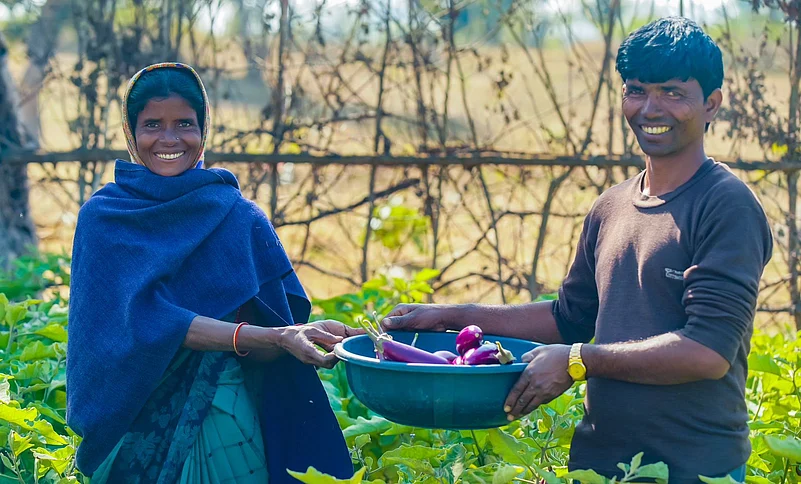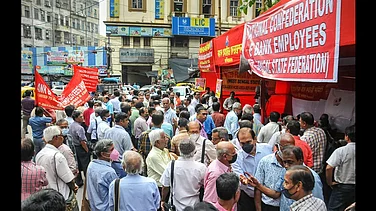Even though the free ration program provides a critical safety net for millions in India, it is essential for the government to periodically reassess how many of the 80 crore beneficiaries have achieved financial independence and may no longer require such support, says Atul Satija, founder and chief executive officer of The/Nudge Institute.
"This can help us understand how we can better utilise the capital and effectively allocate these resources to promote inclusive economic growth," says Satija.
In this interview with Outlook Business, Satija sheds light on the institute's collaboration with central and state governments to address poverty. He also delves into the increasing adoption of public-private partnerships in India.
Edited Excerpts:
Tell us about some of The/Nudge Institute's key initiatives with the state and central governments to address poverty. Also, since poverty is a broad issue, especially in a country like India, what is your primary focus area?
At The/Nudge Institute, we are driven by a clear mission: working towards a poverty-free India within our lifetime. This is why we have partnered with 10 state governments, along with markets and civil society, to enable economic inclusion for the most vulnerable. The intention is to support the government’s National Rural Livelihood Mission and State/UT Rural Livelihood Missions that already do intensive work in this space.
Using the carefully targeted design of the Economic Inclusion Program (EIP), we are already supporting central and state governments for economic inclusion of 3 lakh households, serving 1.5 million people across 10 states. The focus is on helping the marginalised households and women build the capacity and confidence to take advantage of the economic opportunities already existing through government welfare schemes. Additionally, we are also supporting them with livelihood planning, grants, consumption support, coaching, and more to help them find sustainable and diversified livelihoods, become food secure, and beyond.
The results of this program design to empower Didis around the country have been inspiring and multi-dimensional. We found that 96 per cent of the households had diversified their livelihoods, and there had been a two-fold increase in income raised from agriculture and 3.3X rise in livestock-linked income. Also, 95 per cent of respondents consumed three meals a day as compared to the 18 per cent measured at baseline.
Our Indian Administrative Fellowship (IAF) program run with several state and central governments is another example of successful public-private collaboration. Through this, we help bring in senior corporate executives to support governments – where they work with civil servants and bureaucrats and together strategise to advance large-scale technology-driven solutions.
As a non-profit institute, how much do you focus on research to offer solutions?
We look at the critical problem areas that align with our mission and focus areas, such as how reading glasses can accelerate livelihood opportunities or on how the female labour force participation rate can be increased.
While we haven't conducted an extensive amount of primary research at a sector level, we do carry out several literature learning synthesis projects and release distillation summaries and comprehensive reports of key findings to the broader external ecosystem as well, with a strong bias towards action.
When we identify and select a space that we want to develop a solution-oriented program for, such as regenerative agriculture transition or exploring big opportunities for smallholder farmers, we conduct primary research on ground.
The stage that we are in along our journey in a specific problem space determines our research approach. This serves as a vital part of our solution-building.
We also drive research with our collaboration partners – whether with organisations like Mphasis to research women and digital microwork opportunities, for the Delhi Skill and Entrepreneurship University, or working on a report on skilling with HSBC, among others.
Despite numerous policy measures introduced by the government, their on-ground implementation often falls short of achieving the desired impact, whether due to bureaucracy or poor data system. Have there been any discussions or dialogues addressing these challenges and potential solutions?
Governments are working towards capacity building within their bureaucracies, investing hard work and resources. We have observed that, in many cases, the government actively partners with non-profits like us and recognises the unique skill-sets and capabilities that we bring to the table.
In the case of our Economic Inclusion Program, for instance, we understand the technology, livelihood research, data, impact assessment, and the design of poverty alleviation graduation programmes. As a result, we have found governments to have been very welcoming of our technical assistance across the country, including letting us support them in scaling economic inclusion nationwide.
We have also observed the willingness of governments and civil servants to engage in public-private partnerships with visions to accelerate technology-led solutions or changes in the country with our Indian Administrative Fellowship, as well.
As per a Niti Aayog report, nearly 24.82 crore have escaped multidimensional poverty over the last nine years. But the central government continues to find it important to provide free ration to over 80 crore people in India. Does it mean the stress persists?
Providing free ration to a large amount of people in the country serves as a crucial safety net, giving people a certain amount of cushion that allows them to focus on more productive capacity building. This is important to various communities, particularly including those in remote and rural regions. Its benefits are clear – it helps address people’s immediate needs of sustenance and improves food security, while also enhancing social security. This means that more households can allocate their money towards other needs such as building long-term, sustainable livelihoods, without the constant worry of where they will get their next meal.
However, it is still important for the government to continually reassess how many of these 80 crore people, for instance, are now financially independent and not in need of such assistance. This can help us understand how we can better utilise the capital and effectively allocate these resources to promote inclusive economic growth. As we look ahead, I believe that findings from the upcoming Socio Economic and Caste Census (SECC) will become an important foundation to help shape these decisions for future years, and we truly hope that it serves that purpose.
What is your assessment of the way India derives its poverty numbers? Do you think India’s current poverty line, set using the Tendulkar Committee’s recommendations more than a decade ago, is a correct measure for multidimensional poverty in India? Many argue that the existing method doesn’t fully take into account the rising costs of living and access to basic services like health and education.
The manner in which India derives its poverty numbers has evolved greatly over the years. Today, the current assessment of multidimensional poverty does not rely on the Tendulkar Committee’s recommendations regarding the poverty line. Instead, it focuses on what the World Bank has created as a frame.
In India, NITI Aayog collaborated with the United Nations Development Programme (UNDP), and Oxford Poverty and Human Development Initiative (OPHI) to develop a customised national framework – the National Multidimensional Poverty Index or NMPI, which is frequently updated to better capture the on-ground realities of poverty in our country.
I believe that it serves India well, particularly as it does not rely simply on somebody’s position based on their income vis-à-vis the poverty line. It takes a more holistic view of the family’s vulnerability and level of deprivation by looking at poverty through the lens of three core dimensions – Health, Education, and Standard of Living. This considers twelve different vital indicators – from one’s years of schooling to whether they have access to housing and cooking fuel. However, to ensure that the framework stays up-to-date, we should keep revisiting it every five years. This can help us upgrade it based on the scenario of the time. For instance, if we reach a point where everyone – and every home – has electricity, it can make sense to replace this with another, more relevant indicator.
We are clear on this: how India derives its poverty number – the NMPI – is not a problem. However, the way we enumerate it needs some work. Once we’re equipped with the findings of the upcoming Census, we will have access to a more comprehensive repository of data that is representative of the entire country, which can help offer a more accurate picture of the country’s poverty numbers. This would be a wonderful way to look at the NMPI with greater clarity.
Now, there is a second point that we must account for. As India’s overall poverty numbers decline, the poorest of the poor may need a sharper focus with special strategies and treatments, tailored to them. For this reason, we’re also building our own tools – the Poverty Assessment Tool, for one – to specifically understand the extent of vulnerability faced by India’s most excluded households. It would be good to see our government look at the bottom 5 per cent differently, especially as we continue to see the nation make great strides in poverty alleviation.
Don’t you think the growing trend of electoral promises centred on ‘freebies’ over the past decade has discouraged India’s efforts to address poverty effectively? Political parties increasingly rely on handouts as a shortcut to winning governance, which, in turn, dampens people’s aspirations for progress and self-reliance.
We have observed that more and more political parties across the country are utilising electoral promises to offer various benefits, asset, or cash transfers to support people. While some of this is necessary to a certain extent, the government needs to continue to build the capacity to implement more complex but nuanced poverty alleviation programmes. Fortunately, we have seen, as capacity of partners like The/Nudge increases, governments, too, have shown greater intent to consider more holistic and detailed approaches in partnership as well.
While economic growth remains a vital strategy that the government continues to use as one effective way to solve for poverty, there is also a need for some welfare measures that support the poor until they can fully benefit from economic progress.
What we consider as the ‘middle’ piece, focused on more nuanced poverty alleviation solutions for the most vulnerable populations, is essential – and we intend to continue building it up. Non-profits continue supporting the government to do that and, in return, they have been open and welcoming to collaborate.
What are your future plans, and how do you envision your approach moving forward?
Currently, our plans are centred on livelihood direct implementation programs and livelihood ecosystem enabling programs.
Our direct grassroot implementation programs work largely to assist the government through two insight-driven evidence-based livelihood programs (EIP and Asha Kiran) that we believe are both scalable and meaningful in the impact that they create. We hope that, through these, we can serve legions of people across the country and mainstream economic inclusion for the poorest of the poor, so that they can access transformative opportunities.
In ecosystem enabling, we have IAF, which I earlier touched upon. A second core focus of our work here is on nurturing and enabling other social entrepreneurs – India’s brightest minds – to solve the India’s wicked, challenging societal problems. By supporting their journeys, we can help scale their impact – so that they, in turn, can create impact for more Indians. We have already supported 200 social entrepreneurs over the last five years.
Additionally, The/Nudge Forum provides a platform for some of India's largest convenings in the development sector, bringing leaders and stakeholders from governments, markets and civil society together, to spark dialogues and collaborative action for transformational change.
Through these two levers of direct implementation and ecosystem enabling, we hope to continue working towards a more inclusive future – where every citizen of our country has an opportunity to thrive.



























